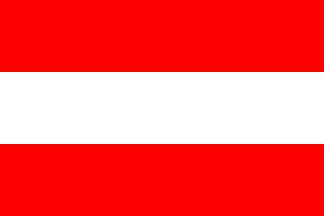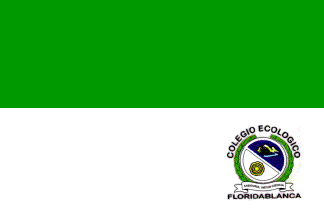 image by Ivan Sache, 21 June 2014
image by Ivan Sache, 21 June 2014
Last modified: 2024-03-02 by rob raeside
Keywords: education |
Links: FOTW homepage |
search |
disclaimer and copyright |
write us |
mirrors
See also:
Other Institutions:
 image by Ivan Sache, 21 June 2014
image by Ivan Sache, 21 June 2014
Colegio Filipense "Nuestra Señora de la Esperanza" was established in
Pasto by the Congregation of the Oratory of St. Philip Neri. Nuns of
the congregation settled in Pasto on 4 October 1961. The building of
an educational institute was decided in 1963 by Mother Esperanza Vaque
and Father Luis Alfonso Muñoz López; transfer to the new grounds was
made in 1966-1967. The two branches of the institute split in 1986.
Source: http://www.filipense.edu.co/ - Institute's website
The flag of the institute is horizontally divided light blue-white-light blue with the institute's emblem in the middle.
Blue is the colour of heavens, meaning that every member of the
institute should keep high views and look farther than the visible
world.
White represents the purity of the Blessed Virgin, the institute's
patron.
The emblem of the institute includes three golden stars on a blue
background, representing the nobleness of the Neri family; a white
dove, representing Pentecost and the conversion of St. Philip Neri; a
red heart representing St. Philip Neri's heart, as the fire of the
Holy Ghost lit in a man's heart, a fire that enlightens darkness; two
lily flowers symbolizing the purity of the Immaculate Virgin, the deep
love expressed by the founders of the institute, and the purity of
heart; and the Latin motto "SURSUM CORDA" (Take Heart!), stressing the
need for all the members of the institute to raise their heart towards
God.
Source:
http://www.filipense.edu.co/index.php/institucional/simbolos -
Institute' website
On the flag in actual use, the background of the shield appears to be
white rather than yellow.
Photos:
http://pasto.gov.co/index.php/alcaldes-de-pasto/category/91-entrega-decreto-colegio-filipense-junio
Ivan Sache, 21 June 2014
 image by Ivan Sache, 10 September 2014
image by Ivan Sache, 10 September 2014
Institución Educativa Finca La Mesa is located in Medellín (Antioquia
Department).
The flag of the institute is white with a dark green triangle placed along the
hoist and the institute's emblem in the middle. White is a symbol of purity.
Green is a symbol of hope and future.
The emblem of the institute is made of a shield bordered in green and divided in
three quarters. The upper left quarter is charged with a book proper, a symbol
of science and intellectual knowledge. The upper right quarter is charged with a
handshake, a symbol of friendship and leadership. The lower quarter is charged
with a lighthouse erected on the top of a mountain, a symbol of progress.
Source:
http://www.iefincalamesa.edu.co/index2.php?id=7384&idmenutipo=339&tag=col -
Institute's website
Ivan Sache, 10 September 2014
 image by Ivan Sache, 13 October 2014
image by Ivan Sache, 13 October 2014
The flag of Institución Educativa Normal Superior de Florencia (Caquetá
Department), designed in 1979 by Carlos Martínez, is horizontally divided
red-white-red. Red is a symbol of power, while white is a symbol of
transparency.
Source:
http://normalflorencia.edu.co/ - institute's website
Ivan Sache, 13 October 2014
 image by Ivan Sache, 22 June 2014
image by Ivan Sache, 22 June 2014
Colegio Ecológico has branches in 10 villages of the south-east and
south-west of the municipality of Floridablanca (Santander Department).
Instituto Rural Casiano was established in 2003 with branches in Altos de
Mantilla, La Judía, Guayanas, Alsacia, Casiano Bajo, Casiano Alto and Los Caucho.
Resolution No. 1,168 of 31 October 2006 merged Instituto Rural Casiano with the
branches of Instituto Gabriela Mistral established in Valle de Ruitoque and
Palmeras and with the branch of Colegio José Elías Puyana established in
Hecheles, to form Colegio Ecológico de Floridablanca.
The flag of the institute is shown graphically horizontally divided green-white.
with the institute's emblem in lower fly. There is no photographical evidence
that flags in actual use are charged with the emblem.
Green represents the resources provided by the fertile soil; it is a symbol of
the natural environment, of youth, desire, rest and balance, aspiration to
progress in the future, and life quality. Green also represents the municipality
of Floridablanca, whose flag is plain green [with a
sun in the middle].
White is a symbol of purity and innocence, of joy, force, optimism, love,
creativity and imagination, reflection and modesty. White conveys a pure and
sincere aspiration to establish peace in Colombia.
The emblem of the institute features:
- a wild cashew tree ("Anacardium excelsum" L.), adopted as the Floridablanca
tree in 1996, as a symbol of nobleness and force. Trees are the lungs and the
source of life of mother Earth.
- mountains, representing the rural development in the municipality.
- water resources, representing the resources of the villages forming
Floridablanca.
- the Guane sun, symbolizing the Guane culture and the progress of the
municipality, also represented on the flag of Floridablanca.
- a laurel crown, representing liberty, leadership and the strong duty to teach
competent students.
Source:
http://colegioecologico.jimdo.com/ecológico/s%C3%ADmbolos/
Ivan Sache, 22 June 2014
 image by Ivan Sache, 11 September 2022
image by Ivan Sache, 11 September 2022
I.E. Fonquetá is located in Chía (department of Cundinamarca).
The
flag of I.E. Fonquetá is horizontally divided blue-white-green with the
municipal coat of arms in the center.
The coat of arms of I.E. Fonquetá,
designed by Eusebio Herrea, is based on a heraldic structure and sketch design,
which was extracted from a pectoral of the Muisca culture featuring a man in
flight position. The upper internal part features the Valvanera church, the
mountains and the moon, characteristic of Chía. The owl means wisdom, the figure
of goddess Chía, a character who identifies the history, culture and origin of
our environment. In the lower part, the petroglyphs, engravings and pictographs
used by the ancestors to communicate and leave the trace of their culture are
described in the form of a snail.
The colors are gold or yellow, which
means the wealth and potential of the Muisca civilization in gold, the joy and
happiness in our students; blue, which means the sky and water and also
represents the loyalty, trust and intelligence of our students; the green, which
means the plant resources of the fields, fertility and freshness; and white,
which means the purity, faith and innocence of the beings that from their
ancestors reflected their ways of life.
The words that accompany the
shield describe the basic skills of education for the active and inclusive
personal development of the Fonquetá community: to be (values), to do (skills),
to know (knowledge) and to live together (harmony in the Fonquetá community).
https://iefonquetachia.edu.co/simbolos - School website
The chapel of
Valvanera, Chía's landmark, was built atop the Valvanera hill (2,780 m a.s.l. It
can be reached from the downtown in a 3-hour walk, using a stoned path with many
stairs, or a 1.5 hour bicycle ride.
https://www.sitiosturisticoscolombia.com/cerro-la-valvanera-chia -
SitiosTuristicosColombia
Ivan Sache, 11 September 2022
 image by Ivan Sache, 16 August 2014
image by Ivan Sache, 16 August 2014
Liceo Fontidueño Jaime Arango Rojas was established in Fontidueño borough,
part of the municipality of Bello (Antioquia Department), by Municipal Agreement
No. 4 of 27 January 1994.
The flag of the institute, adopted on 10 May 1994, is horizontally divided field
green-royal blue-bright yellow. Green is a symbol of the permanent struggle for
the conservation of the ambient environment and the preservation of personal
integrity. Blue is a symbol of the ocean. Yellow is a symbol of life, energy,
enthusiasm, and love.
Source:
http://www.iefarango.edu.co/manual-de-convivencia/emblemas-institucionales -
Institute's website
Ivan Sache, 16 August 2014
 image by Ivan Sache, 03 December 2014
image by Ivan Sache, 03 December 2014
Instituto Nacional de Formación Técnica Profesional (INFOTEP) is located in
San Juan del Cesar (La Guajira Department). Instituto de Carreras Intermedia
Profesional (INCIP) was established by Decree No; 1,098 of 17 May 1979. Academic
programs in Agricultural Husbandry and Animal Husbandry started on 21 July 1980;
they were merged on 21 July 1981 into the program of Agricultural and Animal
Production, while a program in Mining was started. Programs in Pre-School
Education and Accounting were initiated in 1984. The institute was renamed
Instituto Nacional de Educación Técnica Profesional (INETEP) in 1987 and INFOTEP
the next year.
The flag of INFOTEP is horizontally divided gray-red.
Source:
http://www.infotep.edu.co/index.php/institucional/simbolos-institucionales -
Institute's website
Ivan Sache, 03 December 2014